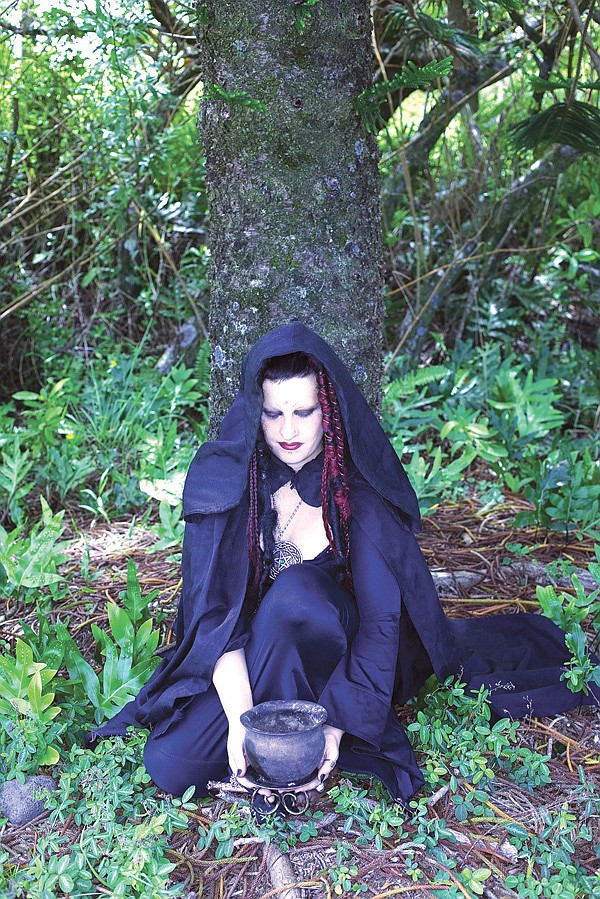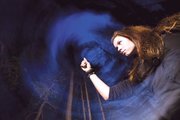THE WITCHES’ WAY
CIRCLES CELEBRATE SEASON OF ENDINGS, BEGINNINGS
Local Wiccans joke that this is the image many people expect to see when they heard the word “ritual.” Most of the time, they say, it’s a complete misconception.
Saturday, October 27, 2012
LITTLE ROCK — Agroup of Wiccans gathers around a bonfire in a clearing in the woods.
Over their faces, they wear masks, some terrifying, and some scream and shout as they channel the characters they portray.
They’re not worshiping Satan or dressing up as demons, said Cat Fury, one of Fayetteville’s out-of-the-broomcloset witches. The masks represent the participants’ worst fears, and they have devoted their time in this particular circle to meditation and visualization aimed at overcoming their personal demons.
“So everybody might put on their masks as trophies,” Fury said.
At this particular gathering, one woman spoke of an alcoholic family member who was often angry and therefore frightening. Looking through the mask that portrayed the alcoholism, she found empathy.
“She definitely had some epiphanies,” Fury said. “It’s hard to be afraid of something - or someone - you have empathy for.”
Just as anyone else might do spring cleaning, Fury said, autumn is the season when pagans and Wiccans “declutter” - getting rid of possessions, bad habits and even people no longer beneficial to theirlives - as they celebrate Samhain, their new year.
SAMHAIN
The Unitarian Universalist Fellowship of Fayetteville will celebrate the ancient Gaelic festival of Samhain at its regular service at 11 a.m. Sunday.
“At Unitarian Universalist Fellowship, we respect all paths to spiritual truth,” said Chava Schacter, a member of the Fellowship’s Chalice Team. “Therefore we try to celebrate the holidays of diff erent spiritual paths and religions. Some years, we celebrate the Day of the Dead, some years Halloween from the more Christian perspective, and some years Halloween in a more pagan kind of way. That way we feel inclusive of all paths.”
For Sunday’s celebration, which also incorporates the Mexican Day of the Dead, participants are invited to come in costume and to bring a memento of “their beloved dead,” be it a person or a pet. Schacter said there will be opportunity for them to speak of theirloved ones, and songs will be sung.
“We hope to get out of it a feeling of closeness to people who have passed on, because pagans believe this time of year the veil between the worlds is thin, and it’s a good time tocommunicate,” Schacter said. The costumes are intended simply to bring joy.
Schacter, too, commented on autumn as “a time of endings and beginnings. Everything is a cycle in pagan holidays, so every ending is a beginning.”
THE WHEEL OF THE YEAR
Most pagan groups - an umbrella designation that encompasses many earthbased spiritual traditions, including Wicca - celebrate the natural cycles of the seasons, known as “The Wheel of the Year.” Eight festivals, sometimes called sabbats, are held at certain times, such as the solstices and equinoxes, Shannon Caine explained in a previous story. The complete cycle of annual seasonal observations completes one round of the wheel.
One of the major festivals is Samhain, the feast of the dead, on Oct. 31. Later comes Yule, occurring in December with the winter solstice, marking the rebirth of the sun and the gradual lengthening of the days.
Imbolc (Candlemas) marks the beginning of spring and the return of the goddess, and Ostara (about the same time as Easter) is the vernal equinox. Beltane (May Day) marks the beginning of summer and growth and the union of the god and goddess. Midsummer (Litha) marks the summer solstice in June. Lughnasadh, or Lammas, is in August, and is a festival of the corn harvest. Mabon celebrates the autumnal equinox. Then it’s back to Samhain, and a new turning of the wheel.
PRACTICAL MAGIC
Cat Fury, who hosts a Community Access Television show in Fayetteville titled “Kitchen Witch,” grew up in an agnostic household. It was the fairies and magic users of science fi ction and fantasy that started her on her road to Wicca, she said.
Part of her belief system, she said, is that the dual gods of Wicca - the Lord and the Lady - “help those who help themselves, and the practice of magic is the first attempt to help yourself.”
“But most of us also fi nish up (a ritual) by basically saying, ‘Lord and Lady, I’m putting this in your hands. Can you help me manifest my wishes?’” she said.
“I don’t see a lot of diff erence between magic and praying, but in magic you take some of the responsibility yourself. One of the things I like about witchcraft is that it tends to be pragmatic.”
But what about Wiccans who choose evil?
“Even if you leave the devil and demonic energies out of it - no witches I know would say they’re ‘in league with the devil’ - I think most pagans believe in the whole threefold law, the law of karma,” Fury said. “If you attempt to make bad things happen, it will just come back on you. The fear of witchcraft seems pretty silly when most modern pagans believe that.”
The biggest misconception witches face is that they worship Satan, Fury said.
“It’s hard to be a Satanist when you don’t believe in the existence of the devil.”
BACK TO THE LAND
Fury said many fellow pagans and Wiccans will spend Samhain picnicking or camping, returning to the nature-based heart of their beliefs.
Diana Rivers and Cynthia Huelsmann, both of whom live near Crosses in Madison County, will join with their circle to ritually remember their ancestors in a grove of cedar trees.
“Sometimes we set up a separate altar and bring pictures of our ancestors and have a beautiful display of candles to honor them,” Huelsmann said. There will be chanting and drumming, the calling of the powers of the north, south, east and west and a welcoming of the spirits of the dead into the circle.
Fury said she and others with whom she practices her faith will do a ritual called a “court change,” something that happens in the spring - at the Sabbat of Ostara - and in the fall, at Samhain.
In the spring, she said, “the nice fairies,” earth spirits that are “about laughter and dance, birth and growth and planting,” ascend to dominate the summer. In the fall, darker spirits rise to teach the harder lessons and test the strength of the believer throughout the winter.
“It all relates to the agrarian cycle of the year,” she explained, the seasons of planting and harvest and survival until time to plant again.
“We’re not worshiping the fairies or spirits,” she said. “We’re not even necessarily thinking of them as entities but as personifications of forces that exist.”
To this ritual, participants might bring “representational offerings” - cut-paper snowflakes, aknife or an arrow honoring the warrior nature of the winter spirits - to place on an altar of hay decorated with pumpkins, grain and gourds.
Fury said the spirits are welcomed and asked to work in harmony with the humans, “to take custodianship of the year until such time as the summer queen can ascend again. People might dress in costume and act it out like a Passion Play or a Nativity scene in the Christian community.”
No matter the ritual choices, everyone of a pagan persuasion remembers that “we are part of nature,” Rivers said. “When we decide to take dominion over it, we start to destroy it. It’s like destroying your house.”
GATHERED ANYWHERE
“What people picture about rituals might be something like we’ve all gone out to some grotto, all in Renaissance garb, holding silver chalices filled with wine we made ourselves,” Fury described with a laugh. “It’s far more likely we’d have plastic cups and some Boone’s Farm around the coffee table - not drawing any circles because of how long it took to scrub the chalk out of the floor the last time!
“But when people bring the right focus to it, it doesn’t really matter.”
Rivers and Huelsmann agreed, but Rivers said “it does connect you more when you can be out in nature. We frequently have done rituals where we drummed and chanted, and the coyotes answered us.”
“It’s really magical when you’re out there in the middle of a ritual, and you’re chanting, and an owl starts hooting or a coyote starts howling,” Huelsmann added. “It’s important to me that I reconnect with nature and understand that I’m just another animal in this big circle of life, in balance with the natural forces around me.”
Religion, Pages 10 on 10/27/2012

